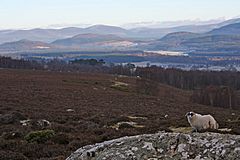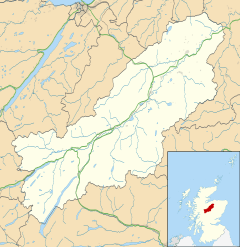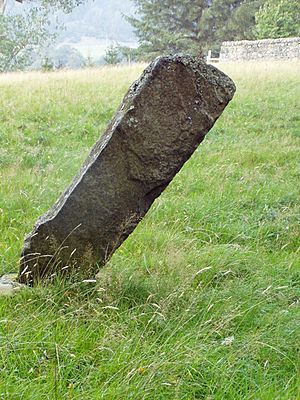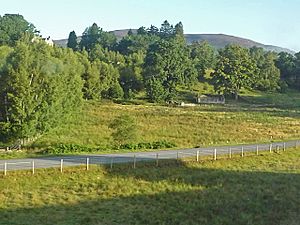Dunachton facts for kids
Quick facts for kids Dunachton
|
|
|---|---|
 Dunachton Moor |
|
| OS grid reference | NH820047 |
| • Edinburgh | 86 mi (138 km) SSE |
| • London | 417 mi (671 km) SSE |
| Council area | |
| Lieutenancy area | |
| Country | Scotland |
| Sovereign state | United Kingdom |
| Post town | KINGUSSIE |
| Postcode district | PH21 |
| Dialling code | 01540 |
| Police | Northern |
| Fire | Highlands and Islands |
| Ambulance | Scottish |
| EU Parliament | Scotland |
| UK Parliament |
|
| Scottish Parliament |
|
Dunachton (Scottish Gaelic: Dùn Neachdain) is a historic area of land in the Scottish Highlands. It is located on the northwest shore of Loch Insh. This area is part of Badenoch and Strathspey in Scotland. It sits just north of the main A9 road.
Experts now think Dunachton might be where the famous Battle of Dun Nechtain happened in 685 AD. This battle was very important for the Picts. It helped them gain lasting freedom from the Northumbrians.
Contents
Discovering Dunachton's Past
The land around Dunachton has signs of people living there a very long time ago. Tools made of flint and special sharpening stones have been found. These show that people were here even before recorded history.
What Does "Dunachton" Mean?
The name Dunachton comes from Dun Neachdain. This means "the fort of Nechtan." We don't know exactly who Nechtan was. He was likely one of the early Pictish Kings who had that name.
Ancient Pictish Discoveries
Dunachton was an important place in the Early Medieval period. An old Pictish stone was found here in 1870. It was being used as a stone in a farm building. This stone is called a Class I Pictish stone. It has a carved deer head and is from around the 7th century.
The stone was put back up in a nearby field. In 2010, an archaeologist noticed it had fallen. So, the Pictish stone was moved to a safe, walled garden on the estate.
The Chapel of Nechtan
Dunachton was first written about in 1381. Records mention the 'capelle de Nachtan', which means the Chapel of Nechtan. This chapel was dedicated to St Drostan.
The Battle of Dun Nechtain
Recent studies suggest that Dunachton might be the real site of the Battle of Dun Nechtain. This battle happened in 685 AD. In it, Bridei mac Bille, the Pictish king, defeated Ecgfrith of Northumbria. This victory made the Picts truly independent from Northumbria.
For a long time, people thought the battle happened near Dunnichen in Angus. But new information and a better understanding of the Pictish kingdom of Fortriu (which was north of the Grampian Mountains) point to Dunachton as the true location.
Dunachton Castle and Its Clans
Dunachton Lodge was built on the remains of an older building, Dunachton Castle. The first landowners were the MacNivens. They were a family group connected to the MacNaughtons. They believed they were related to the ancient Nechtan.
Later, in the early 1500s, the land came into the hands of Clan Mackintosh. This happened when Isabel MacNiven, who owned the land, married William Mackintosh. He later became the chief of Clan Mackintosh.
A long-standing disagreement between the Mackintoshes and Clan MacDonald of Keppoch led to a battle in 1688. The next year, Dunachton Castle was destroyed by Coll MacDonald. This happened during a time of conflict known as the Jacobite cause. The castle was never rebuilt.
Dunachton Today: A Wildlife Park
In the 1950s, Andrew Forbes-Leith bought Dunachton. He later inherited a special title. In the 1970s, he turned about 600 acres (2.4 square kilometers) of Dunachton into the famous Highland Wildlife Park. This park is now a popular place to visit.




